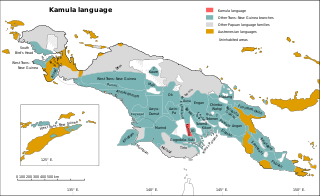Related Research Articles
Kwanga (Gawanga) is a Sepik language spoken in Gawanga Rural LLG of East Sepik Province, Papua New Guinea.

Kamula is a Trans–New Guinea language that is unclassified within that family in the classification of Malcolm Ross (2005). Noting insufficient evidence, Pawley and Hammarström (2018) leave it as unclassified.

Tabo, also known as Waia (Waya), is a Papuan language of Western Province, Papua New Guinea, just north of the Fly River delta. The language has also been known as Hiwi and Hibaradai.
Tirio is Papuan language of Western Province, Papua New Guinea. The Giribam 'dialect' may be a distinct language.
Yerakai (Yerekai) is a Sepik language spoken in Sandaun Province, Papua-New Guinea. It is highly divergent from other Sepik languages, being only 6% cognate with other Middle Sepik languages. Glottolog leaves it unclassified.
Bumbita is an Arapesh language (Torricelli) of Papua New Guinea spoken mainly by older adults, unlike other Arapesh languages. Dialects are Bonahoi, Urita, Timingir, Weril, Werir. It is spoken in 13 villages of Bumbita-Muhian Rural LLG, East Sepik Province.
Yessan-Mayo is a Papuan language spoken by 2000 people in Papua New Guinea. It is spoken in Maio and Yessan villages of Yessan ward, Ambunti Rural LLG, East Sepik Province.
Sepik Iwam, or Yawenian, is a language of Papua New Guinea. It is the lexical basis of the Hauna trade pidgin.
Baramu is a Papuan language of Western Province, Papua New Guinea.
Ngala, or Sogap, is one of the Ndu languages of Sepik River region of northern Papua New Guinea. It is spoken in the single village of Swagap in Ambunti Rural LLG of East Sepik Province.
Were (Weredai), or Kiunum, is a Papuan language spoken in Dewara village, Gogodala Rural LLG, Western Province, Papua New Guinea.
Dibiyasoa.k.a.Bainapi is a Papuan language of Western Province, Papua New Guinea.
Siliput, a.k.a. Maimai, is a Torricelli language of Papua New Guinea. It is spoken in Seleput village, Mawase Rural LLG, Sandaun Province.
Laeko, or Laeko-Libuat, is a Torricelli language of Papua New Guinea.
Bragat is a Torricelli language of Papua New Guinea. It is spoken in four villages, including in Yauan village, Sundun ward, Palmai Rural LLG, Sandaun Province.
Terebu (Turubu) is one of three Kairiru languages spoken in East Sepik Province, Papua New Guinea. It is spoken in Turubu village of Turubu Rural LLG, East Sepik Province.
Tumleo is an Austronesian language of coastal Sandaun Province, Papua New Guinea, on Tumleo Island and the Aitape coast in East Aitape Rural LLG.
Mwatebu is an Austronesian language spoken in a single village in the D'Entrecasteaux Islands of Papua New Guinea. It is spoken in the single village of Mwatebu in Duau Rural LLG, Milne Bay Province.
Lenkau is an Oceanic language spoken in a single village on Rambutyo Island in Manus Province, Papua New Guinea. It is spoken in Lenkau village, Rapatona Rural LLG.

Ali Island is a populated island in East Aitape Rural LLG, Sandaun Province, Papua New Guinea.
References
- ↑ Yakamul at Ethnologue (18th ed., 2015) (subscription required)
- ↑ Eberhard, David M.; Simons, Gary F.; Fennig, Charles D., eds. (2019). "Papua New Guinea languages". Ethnologue: Languages of the World (22nd ed.). Dallas: SIL International.
- ↑ United Nations in Papua New Guinea (2018). "Papua New Guinea Village Coordinates Lookup". Humanitarian Data Exchange. 1.31.9.